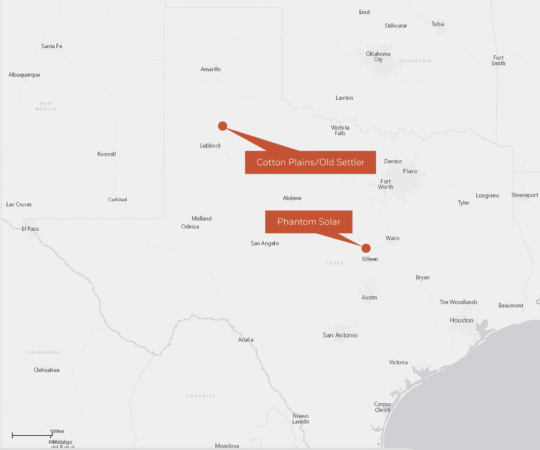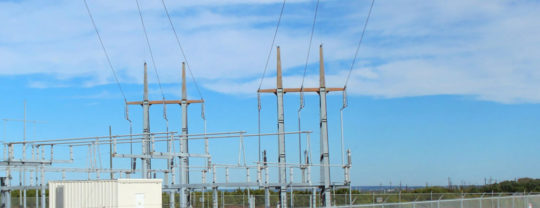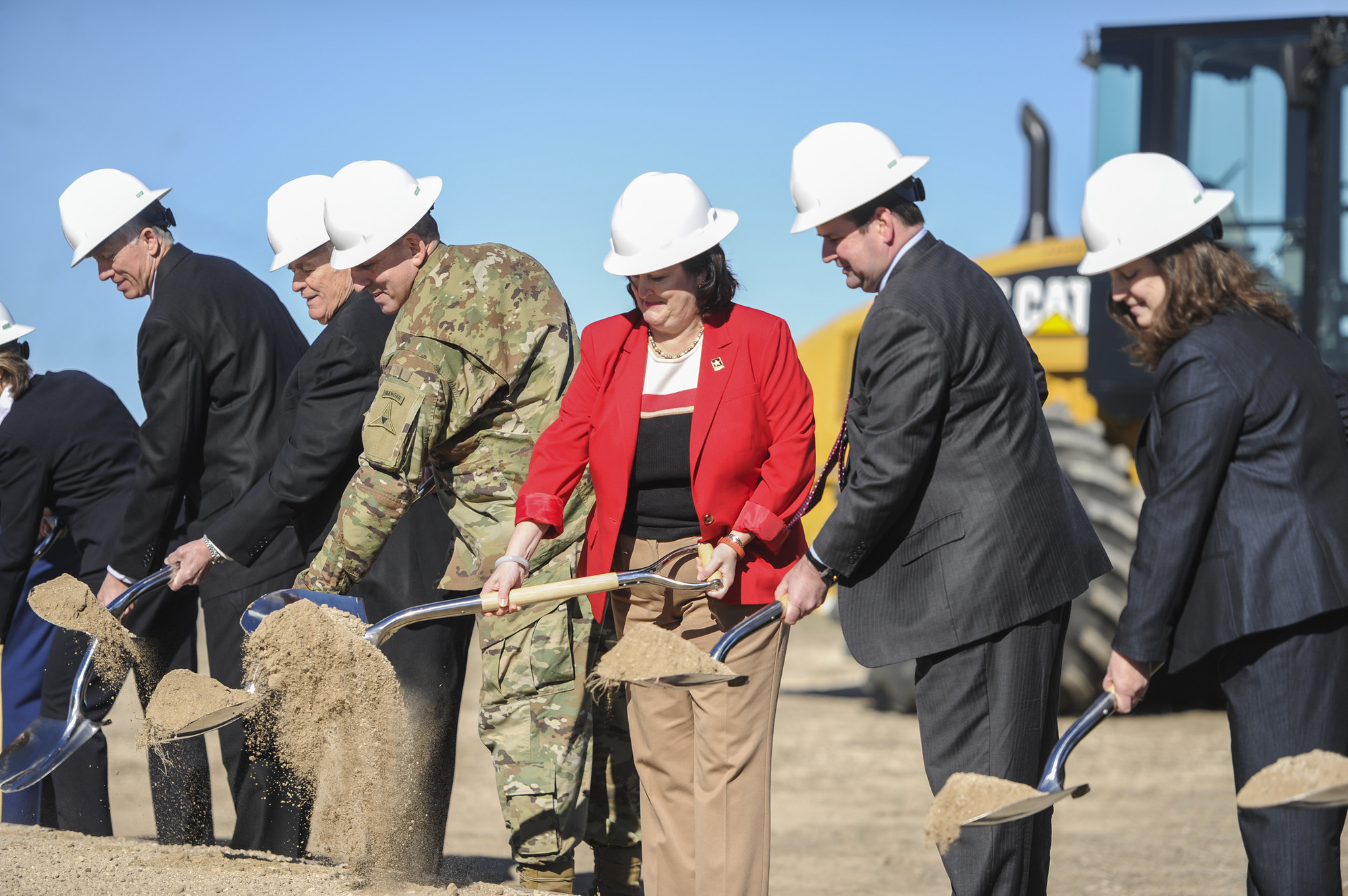Providing Energy Security to Fort Hood
The story of Apex’s power purchase agreement with the Defense Logistics Agency–Energy and Fort Hood, which involves the Army’s largest single renewable energy project to date.
In October 2014, Defense Logistics Agency–Energy (DLA Energy) released a request for proposals (RFP) on behalf of the U.S. Army for a renewable energy supply agreement (RESA) for Fort Hood. Teams across Apex collaborated for months to develop a customized solution to match the aspirational goals of DLA Energy. In June 2015, Apex received a notice of intent to award for the contract. After lengthy negotiations and discussion, Apex and DLA Energy executed a 29-year RESA (28 years of energy delivery plus one year of construction) in January 2016.
The deal—which involves the Army’s largest single renewable energy project to date—is expected to save the Department of Defense (DoD) about $168 million compared to what it would pay for power from the traditional electricity grid over the course of the 28-year agreement.
The proposal drew on the capabilities of Apex’s development, power marketing, finance, and engineering and construction teams.

Fort Hood: A City Unto Itself
The Fort Hood military installation spans over 218,000 acres in Killeen, Texas, approximately 60 miles due north of Austin. Fort Hood, which was established during World War II, is one of the largest U.S. military installations in the world. It consists of 6,348 buildings and structures, 35 million square feet of floor space, and 770 miles of paved roadways and currently supports over 388,000 personnel. Fort Hood hosts 9 schools (which educate more than 24,000 students), 99 barracks, 9 gyms, 2 grocery stores, 2 department stores, 12 chapels, and over 6,700 family quarters.
Through the U.S. Army’s Net Zero initiative, Fort Hood developed an energy program with the goal of modifying behavior and leveraging technology to reduce energy usage at Fort Hood, ultimately leading to the broader goal of net zero energy at the installation. With this objective in mind, and using the authority granted under 10 U.S.C. § 2922a (authorizing the use of U.S. Army land as a location for renewable energy generation systems), Fort Hood worked with DLA Energy and the Army Office of Energy Initiatives (OEI) to release the RFP for a RESA to meet 100% of Fort Hood’s electrical energy requirements.
Leveraging the largest pipeline of projects in the nation, Apex worked to identify the ideal project from its Texas portfolio to meet the RFP’s requirements and soon selected Cotton Plains Wind for its size (50 MW), outstanding wind resource, proximity to robust transmission lines, and late-stage development status.
The Army’s First Hybrid Wind/Solar Energy Project
Under the RESA, Apex will deliver wind energy from the Cotton Plains Wind facility, which is located in Floyd County, Texas, approximately 350 miles from Fort Hood. When complete, 100% of the clean energy and renewable energy credits (RECs) will be delivered on a real-time basis to Fort Hood’s Main, West Fort Hood, and Clarke Road substation meters. On average, the wind energy produced and delivered to Fort Hood will meet approximately 50% of the current annual energy consumption of the Fort Hood substations. The nearby Old Settler Wind, which is not contracted under the RESA but is considered part of the renewable energy complex with Cotton Plains Wind and Phantom Solar, will generate enough clean electricity to power an additional 51,000 average U.S. homes.
The deal—which involves the Army’s largest single renewable energy project to date—is expected to save the Department of Defense approximately $168 million.
Phantom Solar, to be located on-site at Fort Hood, is a 15.4 MWac solar project that will consist of approximately 62,000 solar modules and cover around 130 acres of land. Phantom Solar will be connected behind the utility meter and will directly interconnect via new on-site distribution lines constructed as part of the project. The project is also designed to be adaptable for microgrid technology. The combined Cotton Plains Wind and Phantom Solar represent the first hybrid project contracted and installed on a U.S. military installation. The two production profiles complement one another, producing a balanced and diverse supply of electricity that will not only meet Fort Hood’s needs 24 hours a day, but also provide the most resiliency to its electric grid. Other innovative features of the RESA include:
- A project structure that includes 24/7/365 renewable energy delivery from both on- and off-site locations combined with conventional energy
- Awards Texas the distinction of contributing the most renewable energy to the Army of all the states

Pursuing a Shared Mission
The Fort Hood deal brings the Army closer to President Obama’s 2012 announcement of the DoD’s commitment to clean energy with the goal of deploying three gigawatts of renewable energy—including solar, wind, biomass, and geothermal—on Army, Navy, and Air Force installations by 2025.
The federal government is the largest energy user in the country, and the Army is the largest facility energy user, according to Assistant Secretary of the Army for Installations, Energy, and Environment Katherine Hammack. In a clear demonstration of renewable energy’s cost savings, the Army will avoid paying approximately $168 million over the life of the RESA with Apex. The fixed-firm price of the agreement is lower than the projected price of conventional electricity over the 28-year delivery period, so although the Army will continue to use traditional energy sources to supplement the complementary wind and solar facilities, the RESA will result in a lower cost of electricity year over year.
In January 2016, the Army held a groundbreaking ceremony for Phantom Solar at Fort Hood with high-ranking government officials, who praised the project for its capability to ensure a consistent, affordable, and secure energy resource for Fort Hood—and the U.S. military as a whole—for years to come.
